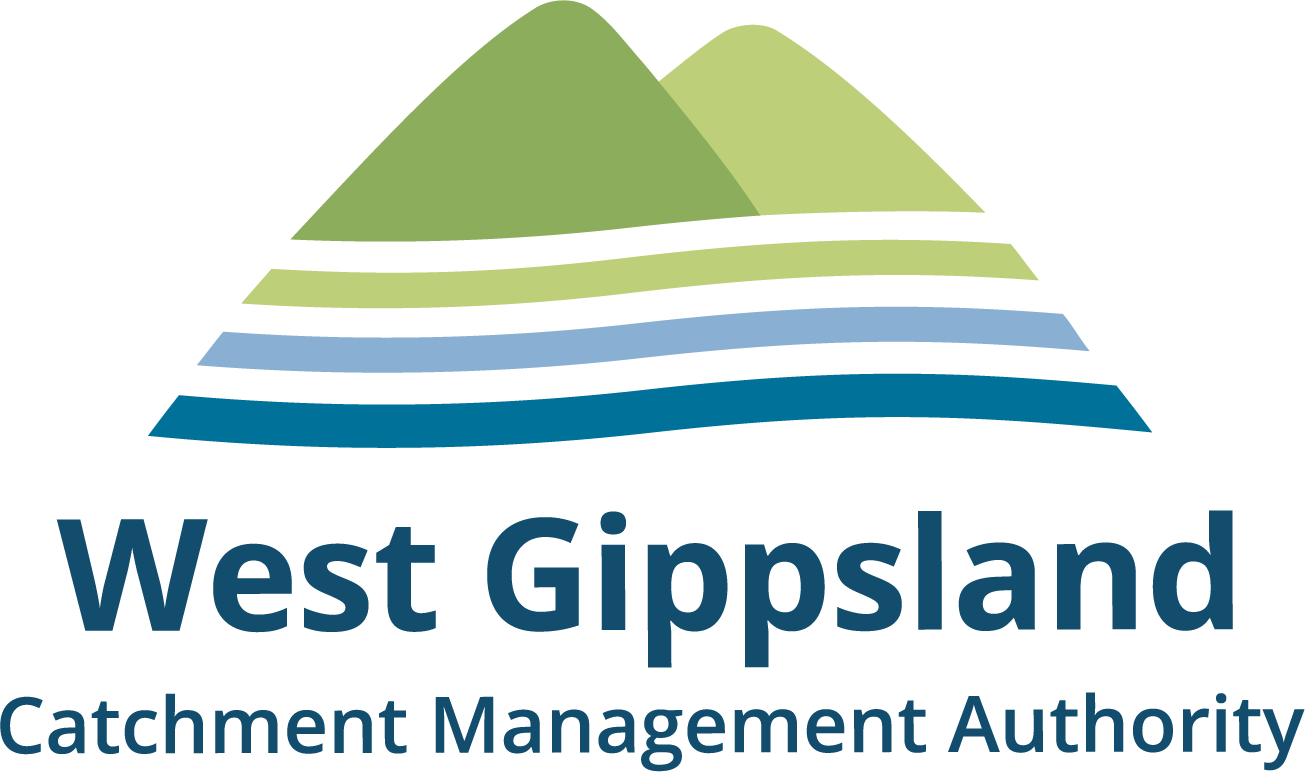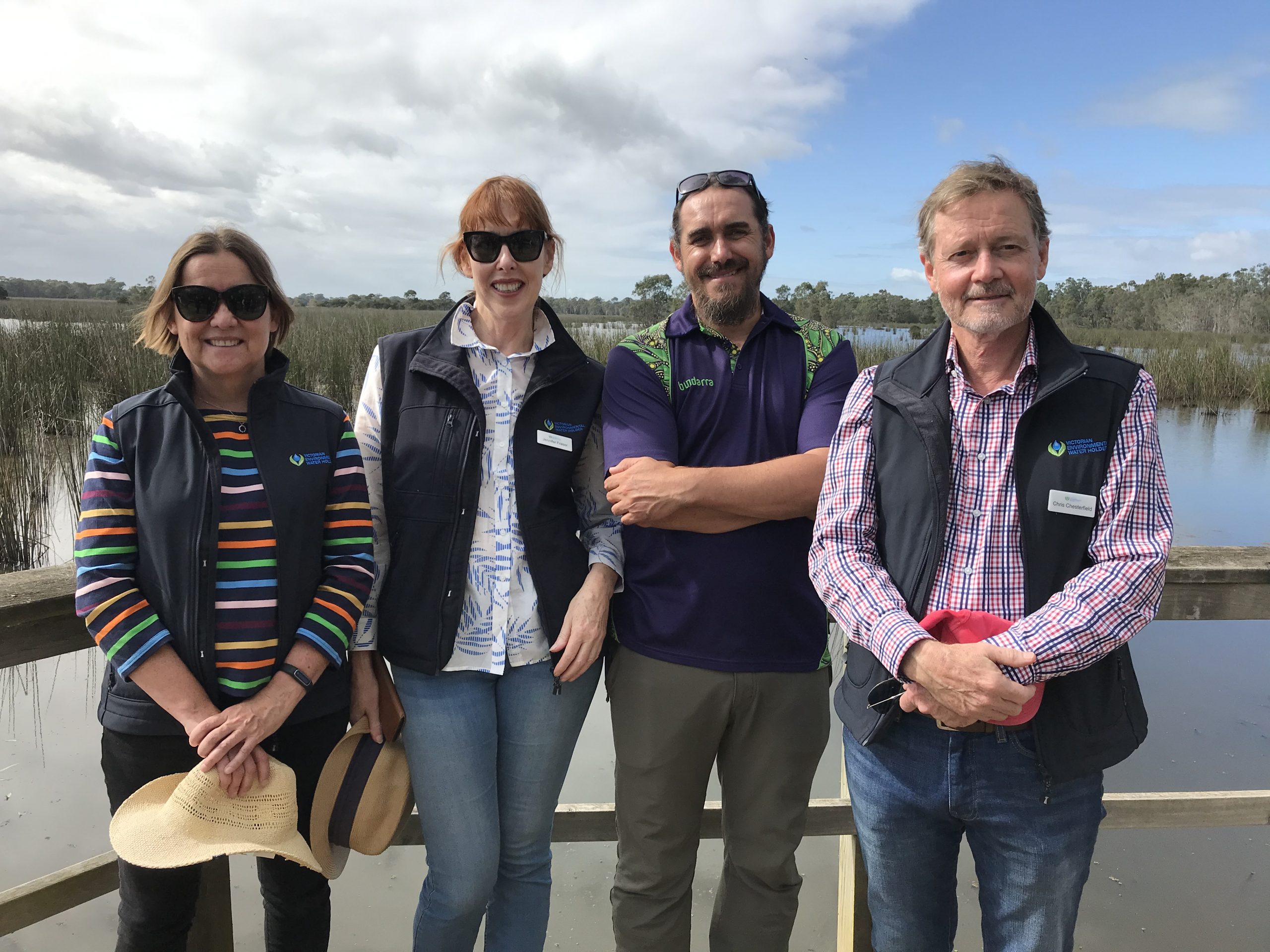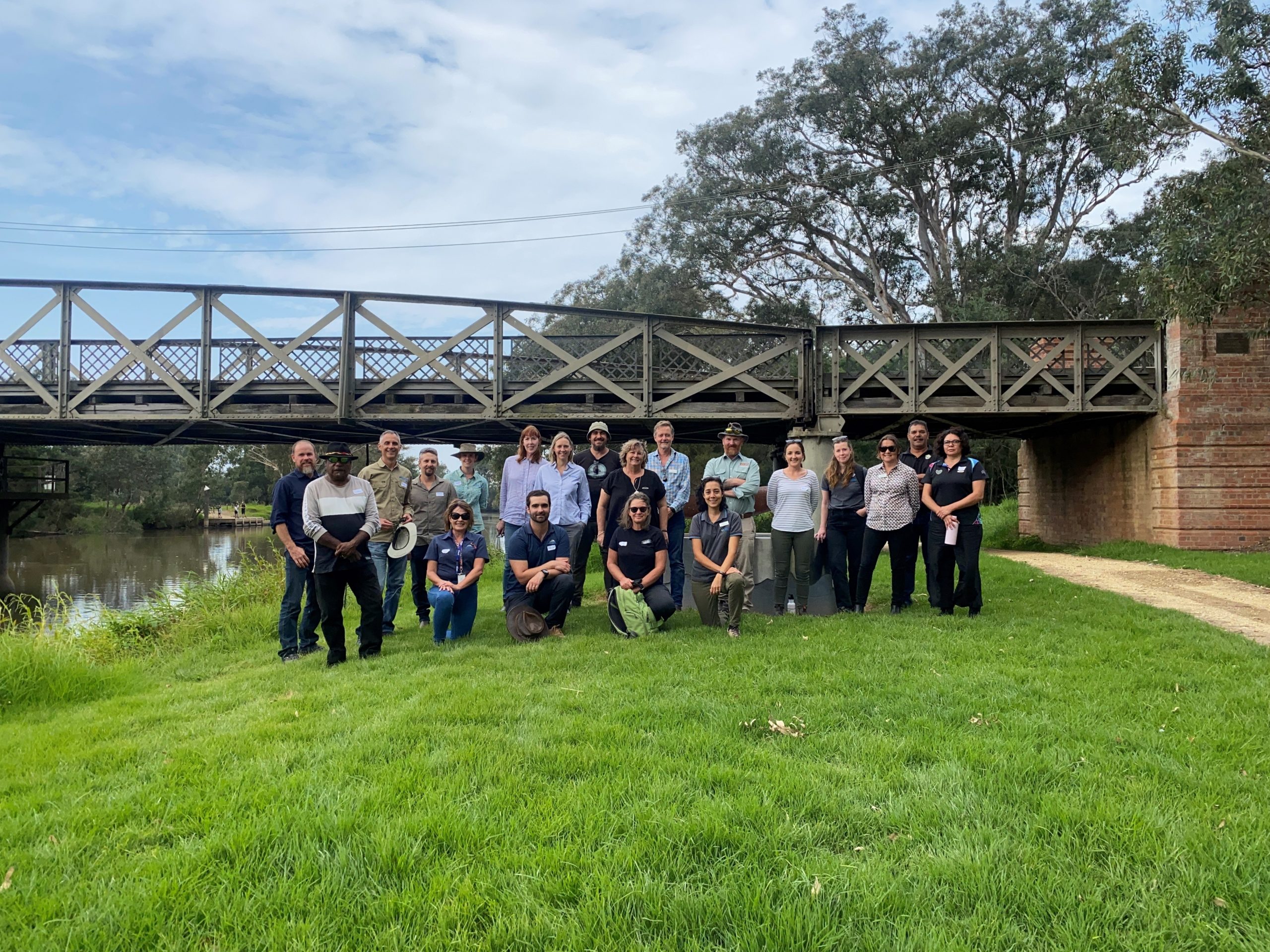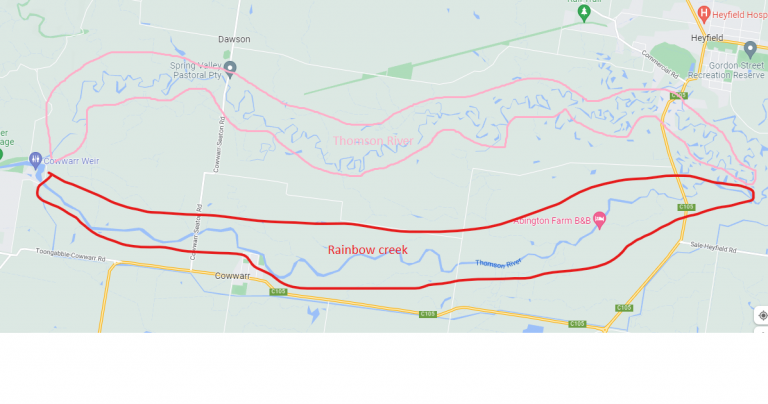
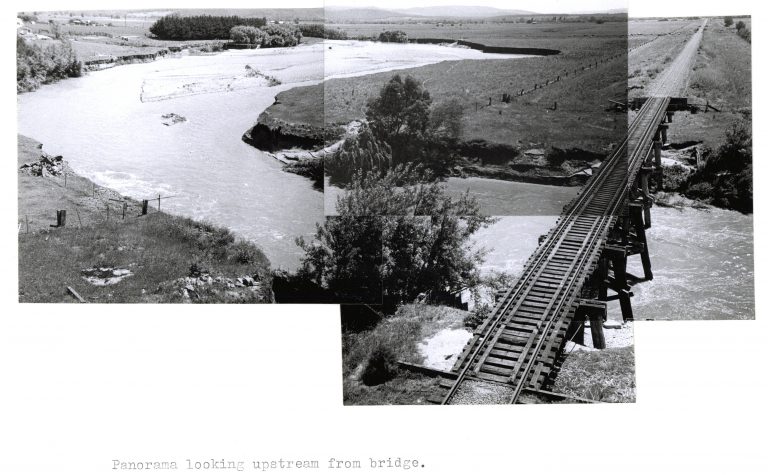
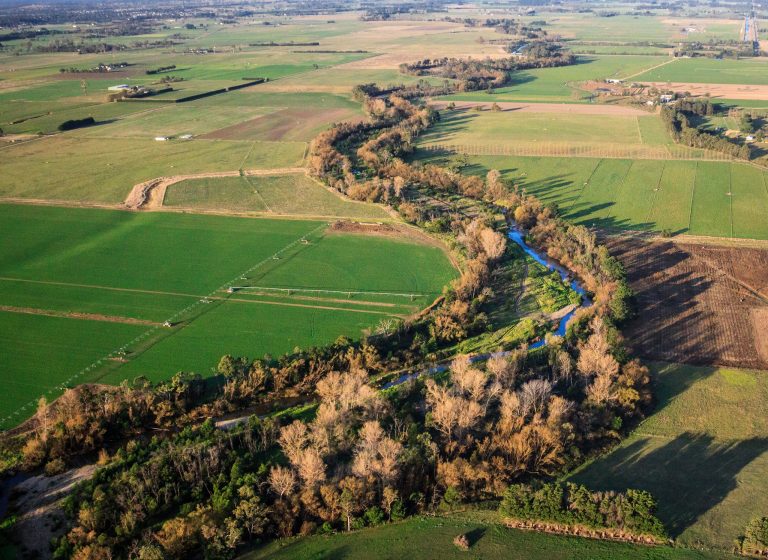
While the election campaign for state parliament might be over, the real battle in Gippsland is just about to get started!
Landholders around the Rainbow Creek near Heyfield and Cowwarr, supported by the West Gippsland Catchment Management Authority (WGCMA) are taking on Google to right a wrong.
“All we want is our Rainbow back,” said David Stork of the WGCMA.
“Google Maps insists on labelling the Rainbow Creek as the Thomson River when in fact they are two separate waterways.
This is more than a petty annoyance, rivers and other waterways are major landmarks in Gippsland so having them labelled correctly for visitors and locals is important.”
The Rainbow formed as a breakaway from the Thomson River in the 1950s and at the time caused major erosion, loss of productive farmland and a loss of flow into the Thomson River.
The flood event that saw the Rainbow Creek formed even led to a secessionist movement for landholders to declare a separate state within Victoria.
“If it was a case of clicking our heels three times and wishing the Rainbow were correctly named, that would be lovely. Unfortunately, this is Google we’re dealing with, so we need to try another tack.
“What we need and would be grateful for is members of the community to join the fight by going to the Google Community Groups page at bit.ly/gippsrainbow and either voting the comment up or leaving a commentin support of the name correction.
Let’s hope that this campaign can work and that dreams that we dare to dream, really do come true,” concluded David.
Irrigators with a bright idea are being asked to put their hands up for funds to put it to the test.
The Irrigation Demonstration Project is open to all irrigators in central Gippsland working in all fields of agriculture.
“This is an opportunity for those working in irrigated agriculture who have ever had an idea that might have improved efficiency to put that idea to the test and see if it works,” said Land Programs Coordinator with the West Gippsland Catchment Management Authority (WGCMA) Anthony Goode.
Funding is available for a range of activities ranging from paper-based planning through to the purchasing of equipment and monitoring and evaluation.
The project aims to see applications that may help achieve the goals of the broader Lake Wellington Land and Water Management Plan, which is working towards, reducing nutrient loads into the Gippsland Lakes, encourage regional economic growth and reduce greenhouse emissions from irrigate agriculture.
Irrigators have welcomed the initiative with Macalister Irrigation District farmer Liz Shotter farmer encouraging fellow irrigators to get involved.
“In this day and age, the most dangerous thing we can do is stay the same and not adapt. Projects such as this provides opportunity to think outside the square and trial projects on a smaller scale before replicating in a greater capacity.”
$54,000 is available in total which will be split into at least two projects.
Applications open on 21 February, 2022 and close on 18 March 2022.
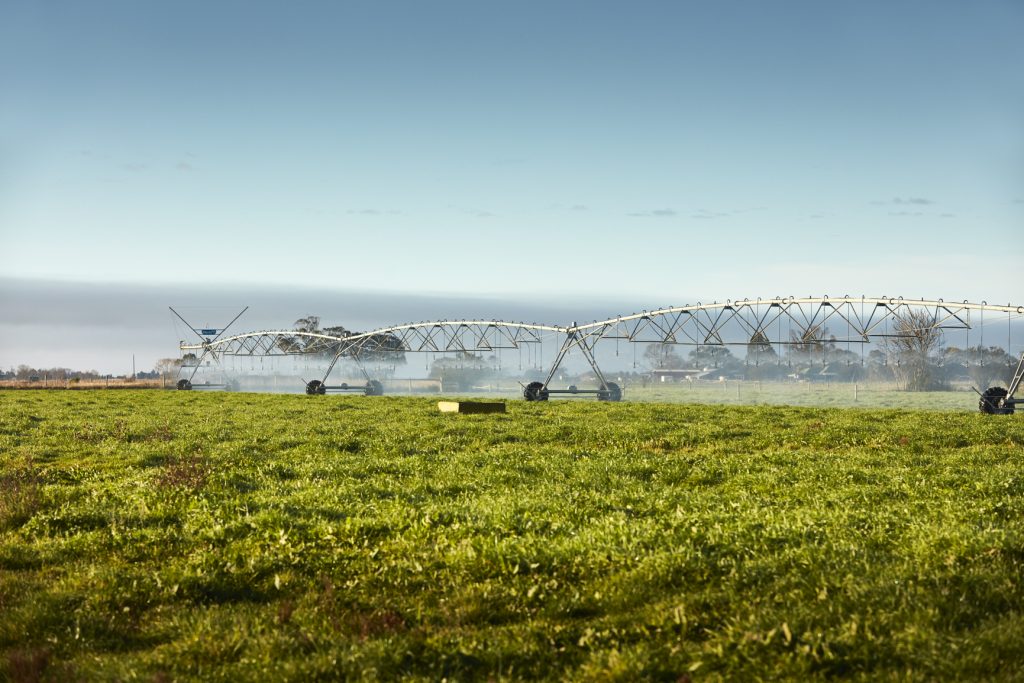
Further information including application form and project overview via Landholder Booklet are available below:
Happy World Fish Migration Day everyone from West Gippsland Catchment Management Authority (WGCMA). The global celebration on 21 May only happens every two years – but connecting rivers to allow migratory species to break free is what WGCMA does every day.
“All fish need to be able to move up and down rivers for food and to breed and 70% of native fish in West Gippsland must migrate between rivers and the sea to survive,” explained WGCMA CEO Martin Fuller.
“Working with the community and partners to restore and reconnect rivers to allow fish to move freely is a highlight of what we do.”
“Fencing and planting of riverbanks restores river health and improves fish habitat. Then the real magic happens when we build fishways and fish ladders to help movement and add water for the environment to trigger migration events,” Mr Fuller explained.
And research reveals that migratory fish are the winners as their river homes are improved and reconnected.
“Work over almost 25-years is seeing a return of healthy rivers able to support the many migratory fish that rely on them to survive and thrive,” says David Stork, Waterways Project Manager for WGCMA.
“This has been achieved by delivering water for the environment in key rivers such as the Thomson and reconnecting the river with a fishway to support migratory native fish like Tupong, Australian Grayling, Australian Bass and eels in their migration.”
“Planned environmental water flows aid migration by releasing the right amount of water, at the right time – giving the fish cues that it is time to move. Flows in autumn and winter support fish to migrate downstream, and spring freshes signal to adults and juvenile fish that it’s time to migrate upstream.”
The story of the migratory Tupong shows the positive impacts of the Thomson River fishway opened in 2019 to connect the upper and lower sections of the Thomson River at Horseshoe Bend. This enabled permanent fish passage to 80 kms of the Thomson and Aberfeldy rivers for the first time in over 100 years.
“The impact was almost immediate. Annual monitoring has shown a return of Tupong populations upstream of the fishway for the first time in 17 years of monitoring.”
The Thomson River is one of the region’s most significant and ecologically important rivers, and the creation of a fishway to allow passage between the Gippsland Lakes to the Victorian alpine region is a state priority.
“World Fish Migration Day is a time to acknowledge work done across the world to connect rivers and we are glad to be playing our part in West Gippsland,” concluded David Stork.
On International Migratory Bird Day this Saturday 14 May, West Gippsland Catchment Management Authority (WGCMA) celebrates the thousands of migratory birds set for take off on their annual migration and asks people to consider switching off their lights to assist these globetrotting birds’ travels.
Light pollution is the chosen theme for the 2022 event with the organising committee stating that the amount of artificial light on the earth’s surface is increasing by at least 2 percent each year, contributing to the death of millions of birds from collisions. Excessive artificial light at night can disorient birds during their migration, leading to fatal collisions with illuminated buildings, communication towers, and other brightly lit structures.
Light pollution can also impact on the timing of migration and other seasonal behaviours by disrupting of birds’ biological clocks. In summary, the committee notes that natural darkness has conservation value in the same way as clean water, air and soil, and should be protected.
“We are lucky that the West Gippsland catchments that support migratory birds, such as Corner Inlet, are away from city lights and are protected through international conventions and programs run by WGCMA and partners,” said Tanya Cowell, Waterways Project Officer for WGCMA.
“Switching off unnecessary lighting to save power and reduce light pollution for wildlife is one simple way we can all help to protect these birds.”
“Corner Inlet is an internationally renowned wetland and important haven for migratory shorebirds that travel incredible distances each year. A favourite of mine is the Red-necked Stint which feeds in Corner Inlet. They are just the size and weight of a matchbox, yet fly thousands of kilometres to nest in the Siberian tundra, before turning around six months later to migrate south once again.”
“Corner Inlet is an internationally renowned wetland and important haven for migratory shorebirds that travel incredible distances each year. A favourite of mine is the Red-necked Stint which feeds in Corner Inlet. They are just the size and weight of a matchbox, yet fly thousands of kilometres to nest in the Siberian tundra, before turning around six months later to migrate south once again.” Corner Inlet became an internationally renowned wetland through the Ramsar convention in 1982. The inlet’s extensive intertidal mudflats provide food for migratory species such as the tiny Red-necked Stint and much larger and critically endangered Eastern Curlew. WGCMA continues to work with partners to protect this special area.
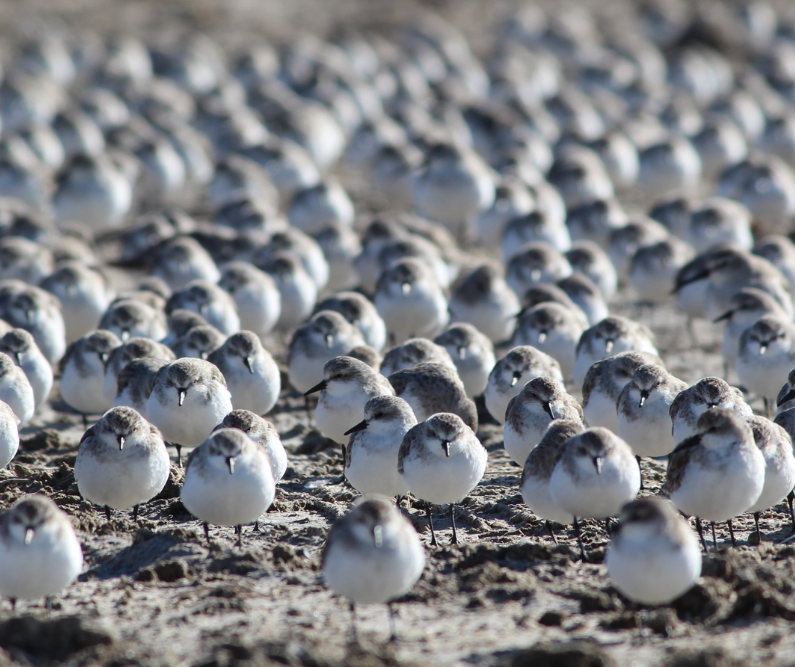
Community representatives from across West Gippsland recently met to kick off the next three-year term of West Gippsland Catchment Management Authority’s (WGCMA) Community Engagement Network.
“The Community Engagement Network or CEN is where we let community members know what work we are doing and priorities we have and they, on behalf of the broader community, can provide valuable feedback on that work and other areas of community interest,” said CEO of the WGCMA, Mr Martin Fuller.
This first meeting of the new term of the network included ongoing and newly appointed community members and was held at the WGCMA’s Traralgon office. The group enjoyed an introduction to the organisation and the vital role working with Traditional Owner groups led by Mandy Leggett, Aboriginal Cultural Heritage Officer for WGCMA.
This was followed by a presentation about what environmental water is, its benefits and how it is managed in West Gippsland from Dr Stephanie Suter, Environmental Water Resource Officer for WGCMA. Dr Zeb Tonkin from Arthur Rylah Institute followed up to share results and insights from research being undertaken on the environmental water flows in local waterways.
There was also plenty of time for members to get to know each other and make connections.
Committee Chair and WGCMA Board member Liz Clay noted that: “Community is really important to the CMA – from planning to partnering to engaging. When CMAs were formed the idea was for local people to take part in managing local places.
Over the years there has been incredible input from this group along with advocacy back to the community. There is a lot of knowledge that is held between these walls.”
Co-Chair and WGCMA Board member Brian Stevens said: “Coming from working with the Aboriginal Community, we value our networks and a good yarn and then we can take it back into Community. There is value in creating space to talk to each other and to listen.”
Executive Manager – Catchment Planning and Delivery for WGCMA, Dan Garlick, sees the new CEN as an important part of the organisation’s work moving into the future. “We are looking forward to working together on priorities such as the Regional Catchment Strategy for example, which will drive how we manage natural resources in the area over the next several years.
This group allows more localised conversations and we will work with the group to make sure we get the best outcomes for the environment and the community.”
The next meeting will be held in June 2022.
World Water Day formed the perfect backdrop for four Commissioners from the Victorian Environmental Water Holder (VEWH) to visit West Gippsland and see firsthand the challenges and opportunities for water for the environment in the region.
The visit, hosted by West Gippsland Catchment Management Authority (WGCMA) in partnership with Gunaikurnai Land and Waters Aboriginal Corporation (GLaWAC) was a wonderful opportunity to learn, share knowledge and talk about future water allocations and the intrinsic connection that Aboriginal people have had to land and waterways for millennia.
The Commissioners spent two days in the region focusing primarily on the role of water for the environment in the Latrobe River system from the upper reaches to the lower lying wetlands.
A key focus was to visit the Latrobe coal mines to discuss rehabilitation options and their implications for the environment, Traditional Owners and the broader community. Rhonda Hastie, Acting CEO of the Mine Land Rehabilitation Authority, presented to the group and answered questions.
In the lower reaches of the Latrobe, the Commissioners toured a private property to learn about the recent achievements of WGCMA in partnering with landholders to maximise the benefits of water for the environment.
Sale Common and Heart Morass in the Lower Latrobe Wetlands were the site for discussions about what a healthy wetland should look like, and the opportunities for Gunaikurnai Traditional Owners to be more actively involved in environmental water on Country.
The VEWH was established in 2011 and works with catchment management authorities and Melbourne Water to ensure environmental water entitlements are used to achieve the best environmental outcomes with the water that is available.
VEWH Chairperson Chris Chesterfield, explained what water for the environment is and its importance: “Many people expect that rivers and creeks take water from rain and runoff and don’t need anything else. The reality is we’ve taken so much water from the environment for purposes such as irrigating crops and providing water for power stations.
“In the recent decade, the government has provided the environment with legal entitlements for water (known as water for the environment) and we manage those entitlements to ptimise environmental outcomes – whether for breeding fish, waterfowl or maintaining vegetation. The role of the VEWH is to hold those water entitlements across Victoria and work in partnership with CMAs to plan how that water should be used.”
“We had members of GLaWAC on the tour and we are really looking to support Traditional Owners to play much more of a role in the planning and decision making for environmental water,” Chris concluded.
“Traditional Owners want to be at the table, be involved and be part of the decision making. This is important not just for Traditional Owners – it’s also important for the health of Country and the whole community,” said Rueben Berg, a Gunditjmara man and VEWH Commissioner.
“It’s about building partnerships. It gives a voice – for me and the Community and that way things will snowball from there and get better. It’s about healing and protecting and to make it right and the best it can be for future generations,” said Nicky Moffatt, GLaWAC Water Engagement Officer.
“We want to get a greater understanding of what’s happening for the WGCMA and also for Traditional Owners and how we can help determine where our environmental water is best used,” said Peta Maddy, Deputy Chairperson for VEWH.
“We came to talk about some of the more complicated water management issues in parts of West Gippsland. We met with the mine rehabilitation authority and they talked to us about the role that water might play in the rehabilitation of the mines and, as a consequence, talked about the complexities of that. For us it’s about listening, learning, and talking,” reflected Commissioner Jennifer Fraser.
“The visit highlighted the importance of water to Traditional Owners and how aspirations are gaining momentum to be more active in planning and managing water,” said Dan Garlick, WGCMA Executive Manager – Catchment Planning and Delivery.
“I am proud of what we have done in the water for the environment arena and the partnership with GLaWAC. Hearing Traditional Owner colleagues talk on Country about the importance of the CMA and what we have being doing to support them was very inspiring.”
Water for the environment releases are planned based on environmental needs, climate forecasts, past flows, and current science. Planned flows and updates for West Gippsland along with information about Water for the Environment can be found here.
The local experience of landholders, communities and government agencies working together to protect the Gippsland Lakes was recently shared with land managers from the Lake Limboto area of Indonesia.
Staff from the West Gippsland Catchment Management Authority’s (WGCMA) Land Management Team shared the story of improving waterway health over the last twenty years.
The workshops were organised by the Commonwealth Department of Agriculture, Water and the Environment (DAWE) as part of Australia’s MoU with Indonesia on sharing water knowledge and focussed on exchanging case studies on Lake Limboto in Indonesia and Lake Wellington and the Gippsland Lakes more generally.
Populated by subsistence farmers, the Lake Limboto area is affected by sediment and run off having a negative impact on waterway health.
“It was fascinating to see the challenges facing Indonesians which are in some ways similar to those faced here twenty years ago,” said Lands Program Coordinator with the WGCMA Anthony Goode.
“One of the major differences however is the scale of the population around Lake Limboto. Where we might work with a few hundred farmers working medium to large scale businesses, the Indonesian team works with thousands of smaller, subsistence farmers growing corn, avocados or working in aquaculture, so they are quite different approaches needed in the two environments.”
Shayne Haywood, Manager of WGCMA’s Land and Biodiversity Team also joined Anthony Goode to discuss how Gippsland farm businesses have been assisted to change practices. Examples included reducing run off from paddocks entering waterways to mitigate negative impacts on the Gippsland Lakes.
“Initiatives include whole farm plans, which help farmers design the most effective ways to irrigate and save water. Incentives to develop re-use dams where irrigation water that runs off paddocks is stored and re-used rather than allowed to flow into drains and then into the Lakes. Assistance to switch to more efficient irrigation techniques, save water and reduce run off were all discussed and explored,” added Anthony.
“These type of interventions over twenty or so years have seen significant water savings, reduction in nutrients flowing into the Lakes and increased profitability of farm businesses.”
The Indonesian delegates to the online forum were interested to hear more detail on a range of subjects ranging from data management and decision processes to measuring the success of projects over several years.
“They were certainly asking some tough questions by the end, which is great and encouraged us to reflect on both the progress of our work so far and how we might improve it into the future. One of the key aspects of all the work we do are the relationships we have been able to build up over many years with landholders, other government bodies and people like farm consultants to help drive and reinforce the constant need to keep on the path we’re on,” concluded Anthony.

Do you live in and love West Gippsland’s catchments? Would you like to get involved in their management and care? Then this opportunity is for you!
West Gippsland Catchment Management Authority (WGCMA) is currently seeking new members for their Community Engagement Network.
“Community engagement and partnerships are a key area of focus for us and pivotal in achieving natural resource management (NRM) outcomes and the delivery of the Regional Catchment Strategy,” said Tash Marty Cripps, Partnership and Engagement Project Officer for WGCMA.
“The intention of the network is to provide a modern and flexible approach to community engagement, and we aim to engage a wide cross section of the community to exchange information about NRM issues in our region,” Tash explained.
“The Network gets together several times a year in one of West Gippsland’s beautiful catchment areas to take a look at the work we do and discuss issues facing the community. In between gatherings, we will link members and provide them with opportunities for input to relevant plans and strategies.”
Tash has personal experience of the benefits of being a part of this community forum being a member before joining the team.
“The CEN was my gateway to working at WGCMA. It facilitated my learning about their fantastic work around the region, allowed me to meet the friendly staff and helped me understand the natural resource issues being managed. It was also a lot of fun! I mean, who doesn’t want to sit on a picnic rug in a grassy area of the Powlett River and listen to a talk about estuary management or Traditional Owner engagement before an informative beach walk and a delicious lunch?” said Tash.
“It tied in with my interests, allowed me to network with other passionate locals and gave me a voice, for example allowing me to provide my feedback during community engagement workshops for the development of the Regional Catchment Strategy. It was those three years with the CEN that convinced me that WGCMA is a place I’d love to work, to contribute more to the management of our land and water resources across West Gippsland.”
Applications are now open for new members to join for a period of three years and must be submitted by 5pm on Friday 4 March 2022.
More information and to register your interest.
This World Wetlands Day, the West Gippsland Catchment Management Authority is inviting people to recognise the amazing role wetlands play in the environment and to heed the call to take action to save the world’s wetlands from disappearing and to restore those we have degraded.
“Historically, wetlands were described as wastelands and landholders were paid by governments to deliberately drain them to allow the land to be used for grazing,” said CEO of the West Gippsland Catchment Management Authority (WGCMA) Martin Fuller.
While that position and approach was common in periods of the twentieth century, today governments and landholders see the benefits of wetlands through protecting existing sites and many landholders, communities and local councils are working to develop new, or re-establish older, wetlands.
“Across Gippsland we’ve got some great examples of wetlands which serve a host of functions in the environment,” said Environmental Officer with the WGCMA Dr Adrian Clements.
“Probably the largest wetland where work has seen a badly degraded site restored is Heart Morass, near Sale and adjacent to the Latrobe River,” said Adrian.
The 1800-hectare Heart Morass site was purchased through a partnership between Field and Game Australia, The Williamson Foundation and WGCMA in 2006 and has been slowly restored in that time.
Gary Howard from Sale Field and Game has been instrumental in the work that has taken place at The Heart over the last 15 years and is still surprised by how the area has recovered.
“You notice it when you look at old photos and realise how far we’ve come. It is amazing really, the weed control, the removal of carp, the planting of tens of thousands of native trees has all transformed the place and really wouldn’t have happened without the support of the Williamson Trust, the work of countless volunteers and Sale Field and Game members and the West Gippy CMA has now largely returned the Heart to a freshwater wetland. It’s the partnership that has brought these results. Amazing really.”
While at one level, improvement to a site such as the Heart is satisfying on an aesthetic level, from the environment and the Gippsland Lakes point of view, wetlands such as The Heart serve a vital function in protecting the Lakes.
“Effectively a wetland like The Heart is a massive filter,” says Adrian from the WGCMA.
“It catches a whole heap of flood water carrying solids and nutrients which we don’t want in the Lakes and allows them to settle in the wetlands rather than in Lake Wellington where they can contribute to algal blooms.”
That open body of water then becomes a haven for wildlife, migratory birds, insects and frogs adding extra layers of benefit from having a restored wetland functioning as it is meant to do.
While Heart Morass is a site with a longstanding history as a wetland, further east on the outskirts of Bairnsdale, a wetland has recently been constructed though funding from the Victorian State Government under its Love our Lakes program, the East Gippsland Shire and the Federal Government.
The East Bairnsdale Wetlands Project was opened in 2016 to capture stormwater from nearby industry and growing residential development.
Wayne Burton Environmental Sustainability Co-ordinator with the East Gippsland Shire Council says that while the site is relatively small and comprises three wetlands with another in development, its function is the same as the much larger Heart Morass site.
“As development occurs it hardens the landscape, meaning when rain events occur, that water moves across the landscape more quickly and in greater volumes with the potential for negative impacts on roads but also the Gippsland Lakes.”
This new wetlands system and approach is known as water sensitive urban design which Wayne says is inspired by nature and how it deals with water flow.
“What we are trying to do here is mimic the natural flow of water. We’re not trying to control it. We recognise that it’s going to flow through to the lowest point and go to where it wants to go.
Now you can try and control it. Good luck with that. So, we’re going to bend with it and work with it which brings us a result like we have here. A feature that is functional as well as an amenity for the community.”
Wayne also notes that a constructed wetland system such as the East Bairnsdale wetland has more capacity to meet demands of heavier rain events as might be expected with climate change.
“They’re not rigid, they’re quite flexible so, apart from providing habit for wildlife, they’re offering filtration services for nutrients, suspended solids, larger pieces of rubbish. They do the whole box and dice really.”
Reflecting on the increasing awareness around the important role of wetlands, CEO of the WGCMA acknowledges the effort put in by community members and others to establish and restore these vital parts of the ecosystem.
“Whether you look at the restoration of someplace like the Heart, the development of new wetland systems like in east Bairnsdale or at Heyfield, where that community has worked successfully to build a wetland over the last 20 years which is a joy to walk around and be a part of, you might say that wetlands are definitely back, doing what they’ve done for thousands of years as well as becoming a part of community life across the region.”
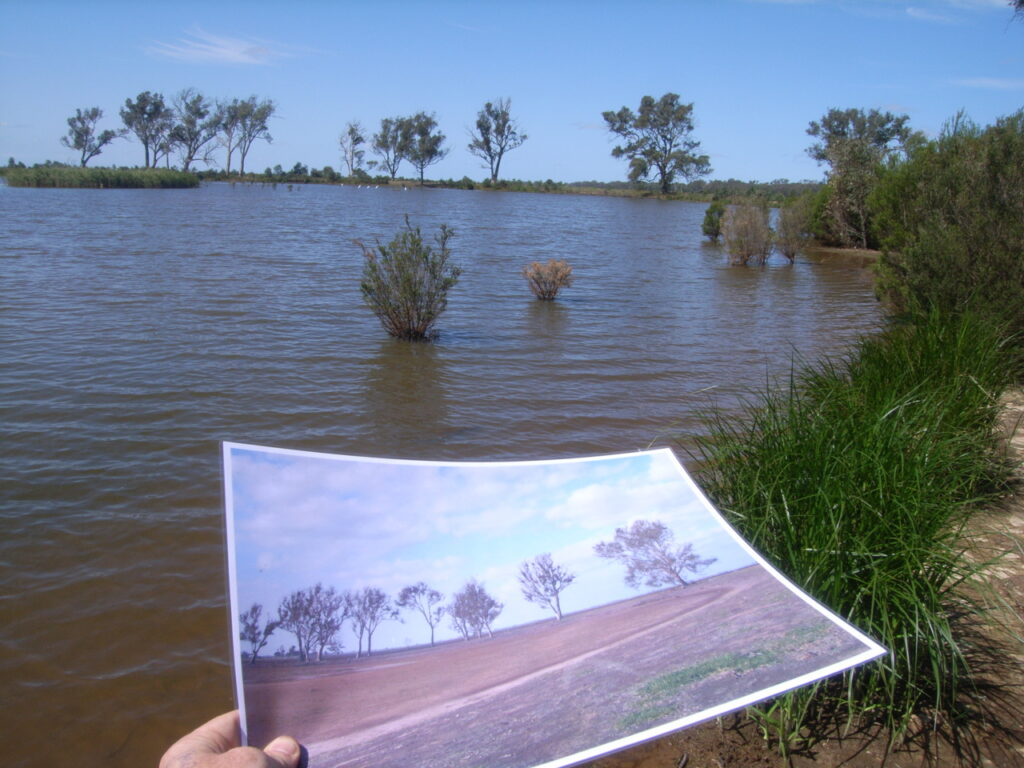 Heart Morass Billabong five years after rehabilitation work had commenced.
Heart Morass Billabong five years after rehabilitation work had commenced.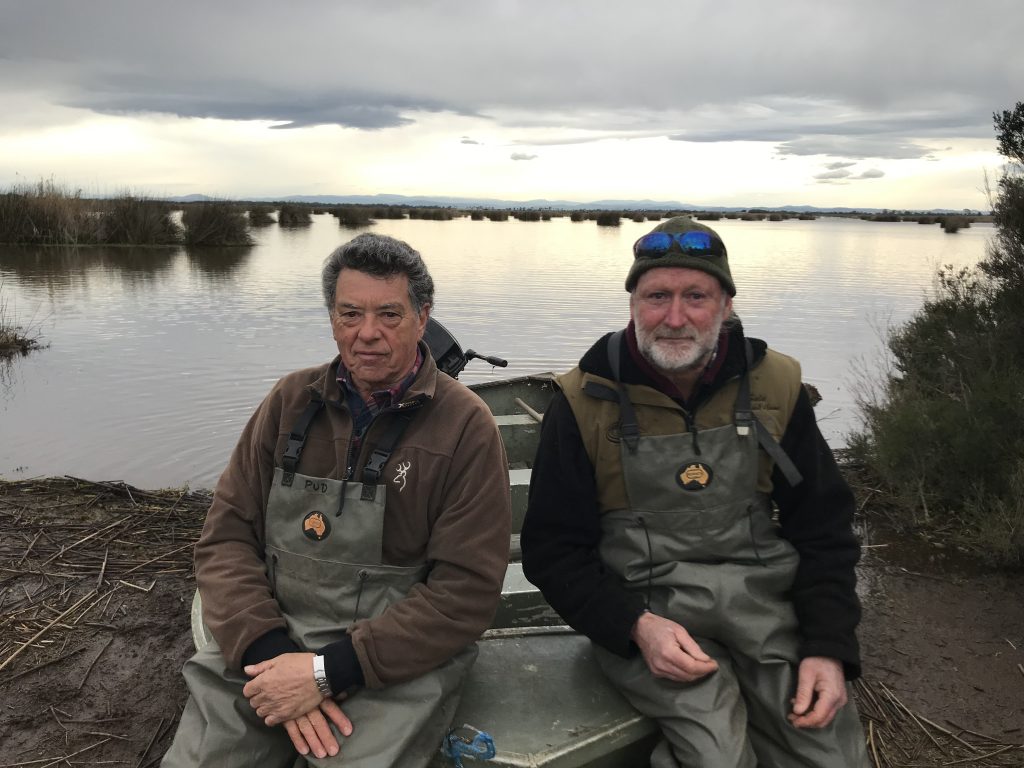 Gary Howard (Pud) & Geoff Glass (Pa) – Heart Morass.
Gary Howard (Pud) & Geoff Glass (Pa) – Heart Morass.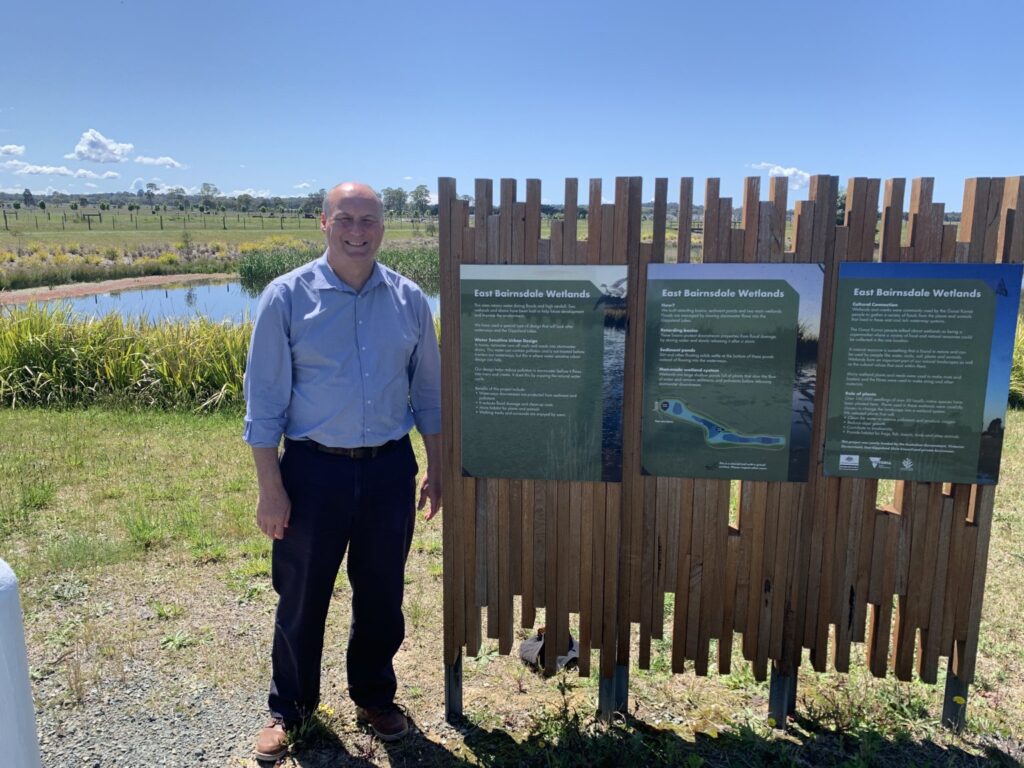 Wayne Burton from East Gippsland Shire at the east Bairnsdale wetland project.
Wayne Burton from East Gippsland Shire at the east Bairnsdale wetland project.
Major flood recovery works to repair damage from June 2021 flood.
The West Gippsland Catchment Management Authority , alongside landholders, other agencies and contractors are set to commence major flood recovery works across the region to to repair damage to waterways caused by the June 2021 flooding which heavily impacted several Gippsland catchments.
“The rain event in June saw a one in 30-year event in the Thomson and Macalister River catchment and something like a one in 75-year event in the Traralgon Creek, so it was pretty huge across the region,” said CEO of the West Gippsland Catchment Management Authority (WGCMA), Mr Martin Fuller.
The WGCMA is charged with responsibility for named waterways in the west Gippsland region both in terms of working with communities prior to flood events but also working to repair damage to waterways and waterway health assets after major floods.
“Waterway management and waterway health are something that we focus on day in, day out. By improving the environmental values of areas also helps to fortify rivers, making them more resilient against extreme events like these most recent floods,” said Martin.
Following the June event, the WGCMA received 100’s of calls from landholders whose land abuts rivers and immediately collaborated on a preliminary response program to repair areas of urgent concern such as major tree removal, fencing repairs and debris removal throughout the region. Working with other bodies such as local government, DELWP, Parks Victoria, Vic Roads and Bushfire Recovery Victoria, more substantial works were coordinated in and around Walhalla where some major damage occurred. Over coming months, WGCMA teams, working with partner agencies, landholders and contractors to continue the coordinated effort that began in June.
Catchment Planning and Delivery Unit Manager at the WGCMA, Dan Garlick says the extent of damage was significant and widespread and when the catchments hopefully dry out, further planned recovery can continue.
“We saw undercutting of river banks and major erosion which carry sediment risks for downstream areas as well as fencing being impacted and waterways impeded by fallen trees. What we’ve been doing since June is firstly assessing that damage, intervening immediately where we have been able to and undertaking planning for the more detailed works required.”
“Walhalla for instance saw significant damage caused by massive flows in Stringers Creek. We’ve been up there, assessed the damage and coordinated effort to repair damage to riverbanks, remove debris and address community priorities including repairs to camp grounds and parks to be utilised by community once again.”
“Over coming months people will see our teams working on more stretches of river doing things like bank stabilisation which includes bringing in rock, rebuilding riverbanks repair fences and vegetation throughout the region.”
“All these works will be done in partnership with communities, other government agencies and landholders so that we can achieve the best possible outcome for those stakeholders as well as the waterway itself,” concluded Dan.
Although floods can be destructive, they are natural and play an important role in waterway health.
Floods provide connectivity between bodies of water that would otherwise remain isolated allowing animals to move between them. Heavy rainfall provides breeding ques and habitat for fish and waterbirds and are an important part of the lifecycle for many aquatic animals. Important floodplain vegetation, such as river redgums, also rely on floods to survive. Floods replenish groundwater supplies and are particularly important for the lower Latrobe wetlands as they provide flushing flows, pushing saltwater out of the system.
In this video, CEO of the West Gippsland Catchment Management Authority Martin Fuller talks about flood recovery, and in this video Dan Garlick the Catchment Planning and Delivery Manager talks about the the damage and some of the works that have been done.
